Designing Effective Early Childhood Programs: EYLF, NQS, Australia
VerifiedAdded on 2023/06/11
|15
|2916
|109
Report
AI Summary
This report outlines a program design for an early childhood setting, guided by documentation, planning, and assessment philosophies rooted in the Early Years Learning Framework (EYLF) for Australia. It explores theoretical and curriculum approaches influencing the program design, emphasizing the EYLF planning cycle, documentation methods, planning tools, and formative/summative assessment strategies. The program incorporates digital technologies and considers meaningful consultation with children and families, appreciation for the natural environment and sustainability, and strategies supportive of all aspects of children’s learning and development. It reflects on the importance of inclusivity and ongoing learning, linking assessment to children's learning experiences and interactions, aligning with the National Quality Standard (NQS).
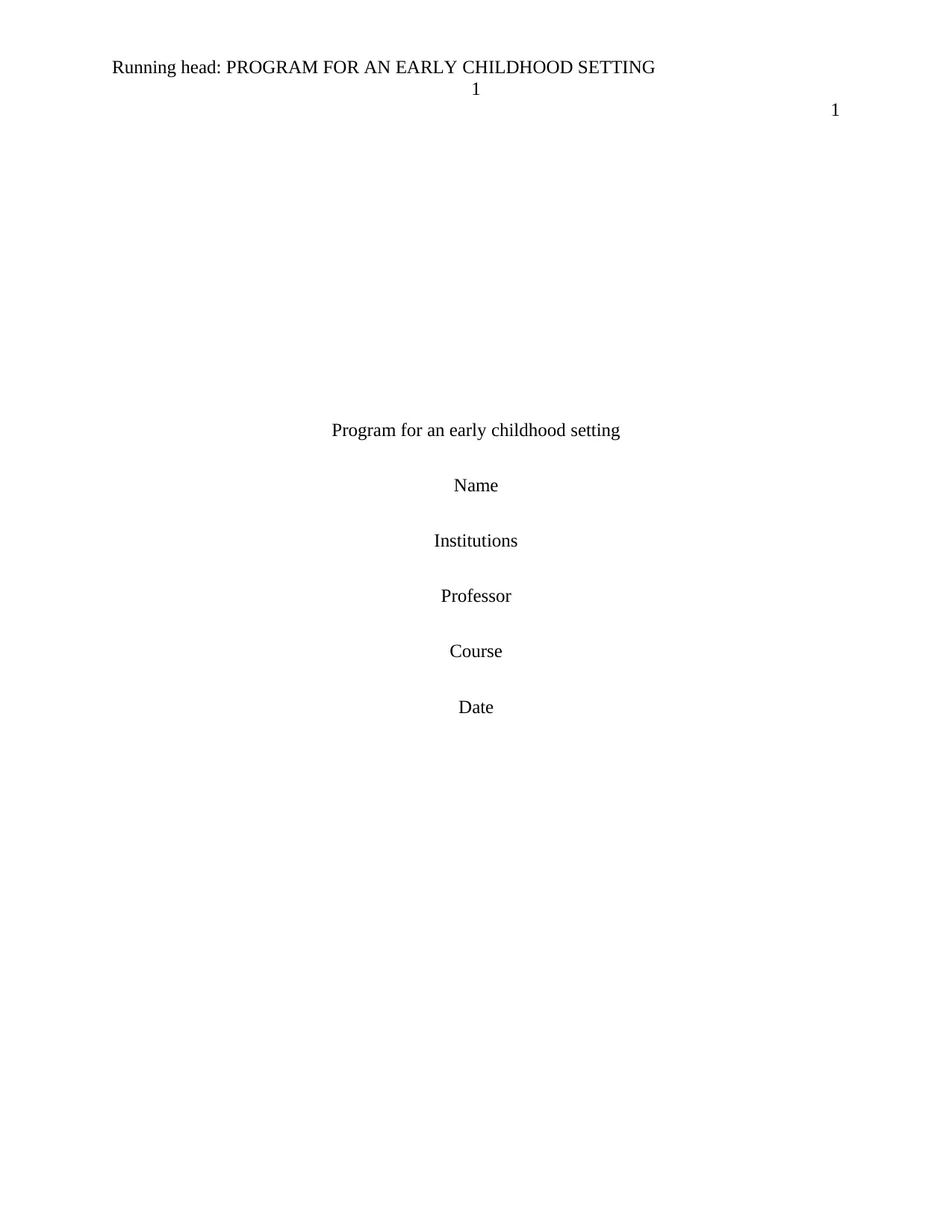
Running head: PROGRAM FOR AN EARLY CHILDHOOD SETTING
1
1
Program for an early childhood setting
Name
Institutions
Professor
Course
Date
1
1
Program for an early childhood setting
Name
Institutions
Professor
Course
Date
Paraphrase This Document
Need a fresh take? Get an instant paraphrase of this document with our AI Paraphraser
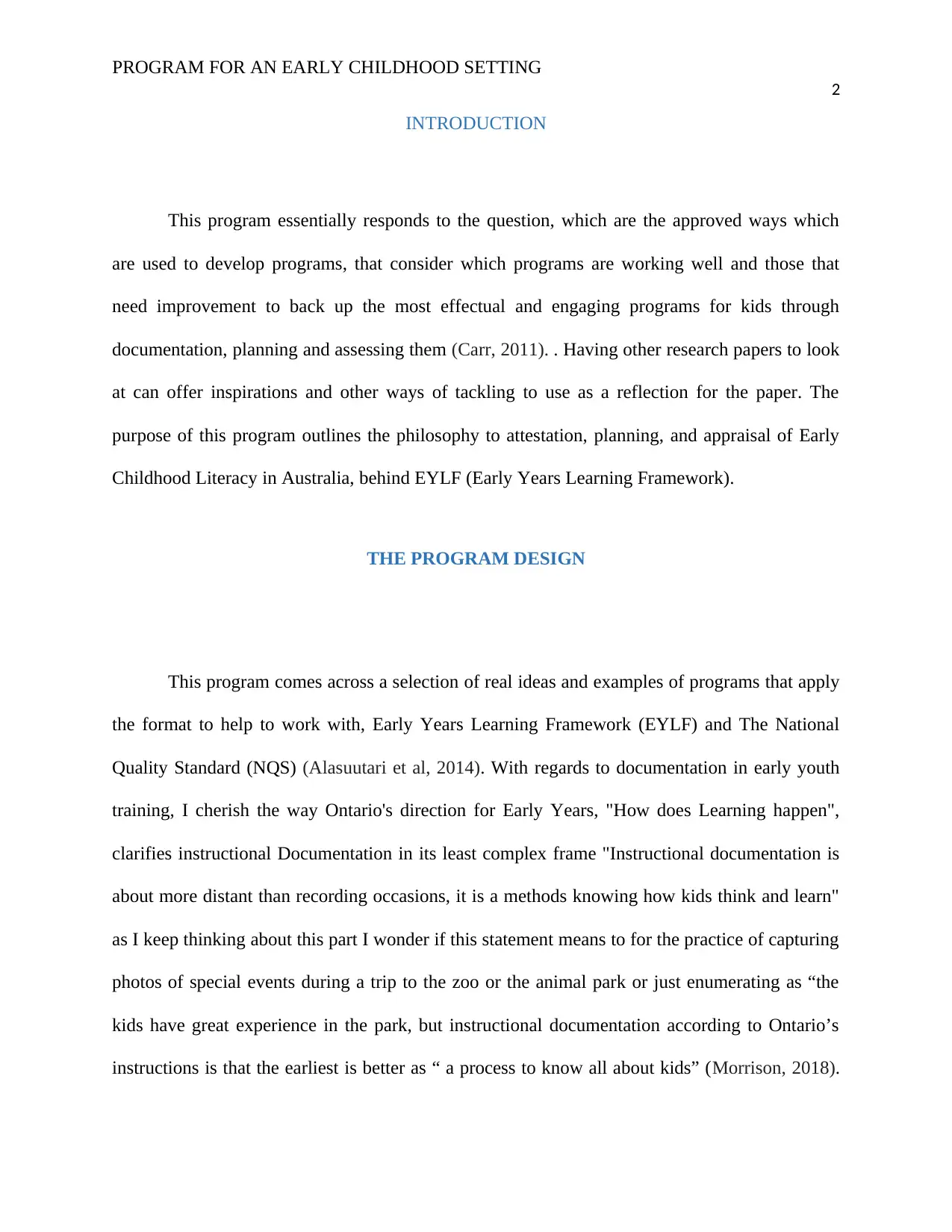
PROGRAM FOR AN EARLY CHILDHOOD SETTING
2
INTRODUCTION
This program essentially responds to the question, which are the approved ways which
are used to develop programs, that consider which programs are working well and those that
need improvement to back up the most effectual and engaging programs for kids through
documentation, planning and assessing them (Carr, 2011). . Having other research papers to look
at can offer inspirations and other ways of tackling to use as a reflection for the paper. The
purpose of this program outlines the philosophy to attestation, planning, and appraisal of Early
Childhood Literacy in Australia, behind EYLF (Early Years Learning Framework).
THE PROGRAM DESIGN
This program comes across a selection of real ideas and examples of programs that apply
the format to help to work with, Early Years Learning Framework (EYLF) and The National
Quality Standard (NQS) (Alasuutari et al, 2014). With regards to documentation in early youth
training, I cherish the way Ontario's direction for Early Years, "How does Learning happen",
clarifies instructional Documentation in its least complex frame "Instructional documentation is
about more distant than recording occasions, it is a methods knowing how kids think and learn"
as I keep thinking about this part I wonder if this statement means to for the practice of capturing
photos of special events during a trip to the zoo or the animal park or just enumerating as “the
kids have great experience in the park, but instructional documentation according to Ontario’s
instructions is that the earliest is better as “ a process to know all about kids” (Morrison, 2018).
2
INTRODUCTION
This program essentially responds to the question, which are the approved ways which
are used to develop programs, that consider which programs are working well and those that
need improvement to back up the most effectual and engaging programs for kids through
documentation, planning and assessing them (Carr, 2011). . Having other research papers to look
at can offer inspirations and other ways of tackling to use as a reflection for the paper. The
purpose of this program outlines the philosophy to attestation, planning, and appraisal of Early
Childhood Literacy in Australia, behind EYLF (Early Years Learning Framework).
THE PROGRAM DESIGN
This program comes across a selection of real ideas and examples of programs that apply
the format to help to work with, Early Years Learning Framework (EYLF) and The National
Quality Standard (NQS) (Alasuutari et al, 2014). With regards to documentation in early youth
training, I cherish the way Ontario's direction for Early Years, "How does Learning happen",
clarifies instructional Documentation in its least complex frame "Instructional documentation is
about more distant than recording occasions, it is a methods knowing how kids think and learn"
as I keep thinking about this part I wonder if this statement means to for the practice of capturing
photos of special events during a trip to the zoo or the animal park or just enumerating as “the
kids have great experience in the park, but instructional documentation according to Ontario’s
instructions is that the earliest is better as “ a process to know all about kids” (Morrison, 2018).
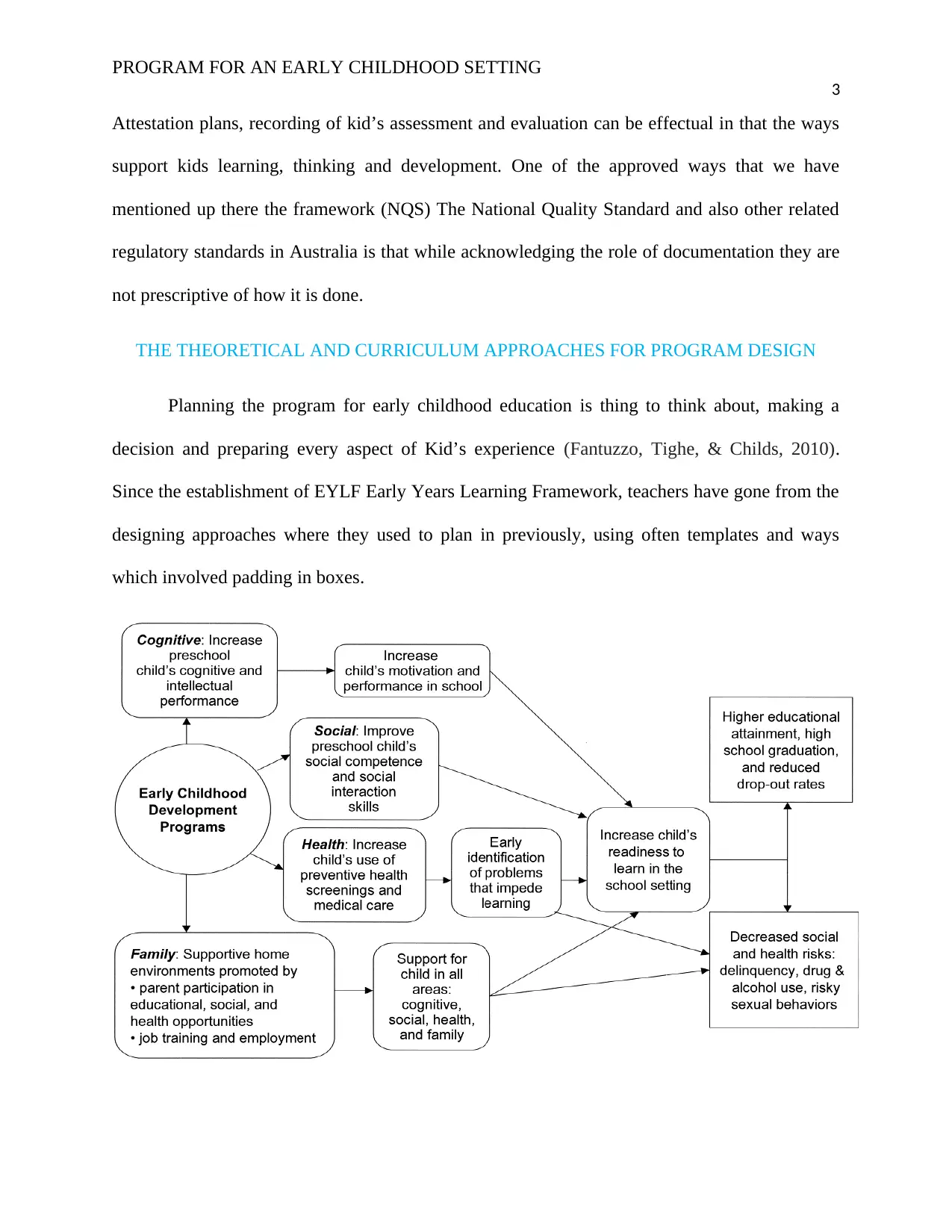
PROGRAM FOR AN EARLY CHILDHOOD SETTING
3
Attestation plans, recording of kid’s assessment and evaluation can be effectual in that the ways
support kids learning, thinking and development. One of the approved ways that we have
mentioned up there the framework (NQS) The National Quality Standard and also other related
regulatory standards in Australia is that while acknowledging the role of documentation they are
not prescriptive of how it is done.
THE THEORETICAL AND CURRICULUM APPROACHES FOR PROGRAM DESIGN
Planning the program for early childhood education is thing to think about, making a
decision and preparing every aspect of Kid’s experience (Fantuzzo, Tighe, & Childs, 2010).
Since the establishment of EYLF Early Years Learning Framework, teachers have gone from the
designing approaches where they used to plan in previously, using often templates and ways
which involved padding in boxes.
3
Attestation plans, recording of kid’s assessment and evaluation can be effectual in that the ways
support kids learning, thinking and development. One of the approved ways that we have
mentioned up there the framework (NQS) The National Quality Standard and also other related
regulatory standards in Australia is that while acknowledging the role of documentation they are
not prescriptive of how it is done.
THE THEORETICAL AND CURRICULUM APPROACHES FOR PROGRAM DESIGN
Planning the program for early childhood education is thing to think about, making a
decision and preparing every aspect of Kid’s experience (Fantuzzo, Tighe, & Childs, 2010).
Since the establishment of EYLF Early Years Learning Framework, teachers have gone from the
designing approaches where they used to plan in previously, using often templates and ways
which involved padding in boxes.
⊘ This is a preview!⊘
Do you want full access?
Subscribe today to unlock all pages.

Trusted by 1+ million students worldwide
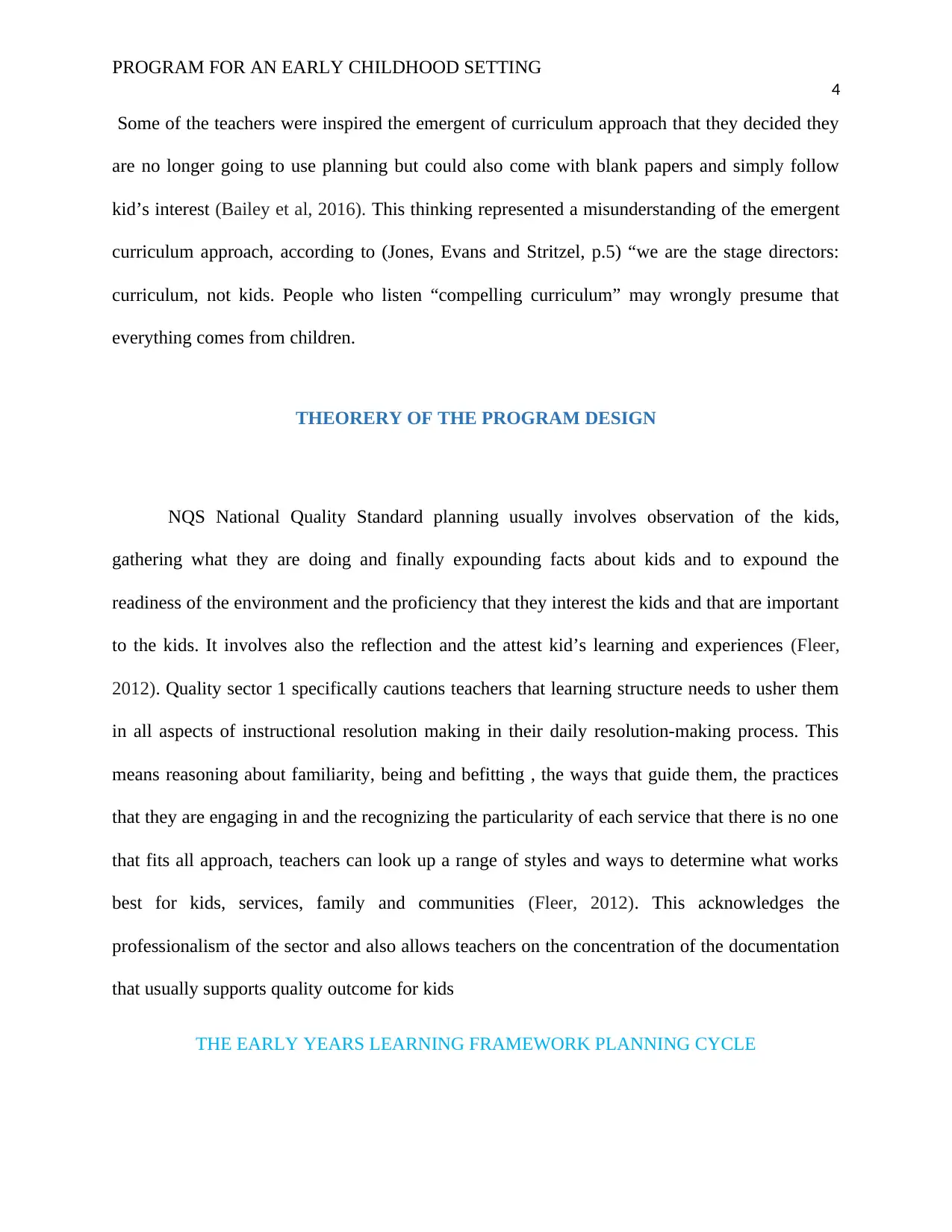
PROGRAM FOR AN EARLY CHILDHOOD SETTING
4
Some of the teachers were inspired the emergent of curriculum approach that they decided they
are no longer going to use planning but could also come with blank papers and simply follow
kid’s interest (Bailey et al, 2016). This thinking represented a misunderstanding of the emergent
curriculum approach, according to (Jones, Evans and Stritzel, p.5) “we are the stage directors:
curriculum, not kids. People who listen “compelling curriculum” may wrongly presume that
everything comes from children.
THEORERY OF THE PROGRAM DESIGN
NQS National Quality Standard planning usually involves observation of the kids,
gathering what they are doing and finally expounding facts about kids and to expound the
readiness of the environment and the proficiency that they interest the kids and that are important
to the kids. It involves also the reflection and the attest kid’s learning and experiences (Fleer,
2012). Quality sector 1 specifically cautions teachers that learning structure needs to usher them
in all aspects of instructional resolution making in their daily resolution-making process. This
means reasoning about familiarity, being and befitting , the ways that guide them, the practices
that they are engaging in and the recognizing the particularity of each service that there is no one
that fits all approach, teachers can look up a range of styles and ways to determine what works
best for kids, services, family and communities (Fleer, 2012). This acknowledges the
professionalism of the sector and also allows teachers on the concentration of the documentation
that usually supports quality outcome for kids
THE EARLY YEARS LEARNING FRAMEWORK PLANNING CYCLE
4
Some of the teachers were inspired the emergent of curriculum approach that they decided they
are no longer going to use planning but could also come with blank papers and simply follow
kid’s interest (Bailey et al, 2016). This thinking represented a misunderstanding of the emergent
curriculum approach, according to (Jones, Evans and Stritzel, p.5) “we are the stage directors:
curriculum, not kids. People who listen “compelling curriculum” may wrongly presume that
everything comes from children.
THEORERY OF THE PROGRAM DESIGN
NQS National Quality Standard planning usually involves observation of the kids,
gathering what they are doing and finally expounding facts about kids and to expound the
readiness of the environment and the proficiency that they interest the kids and that are important
to the kids. It involves also the reflection and the attest kid’s learning and experiences (Fleer,
2012). Quality sector 1 specifically cautions teachers that learning structure needs to usher them
in all aspects of instructional resolution making in their daily resolution-making process. This
means reasoning about familiarity, being and befitting , the ways that guide them, the practices
that they are engaging in and the recognizing the particularity of each service that there is no one
that fits all approach, teachers can look up a range of styles and ways to determine what works
best for kids, services, family and communities (Fleer, 2012). This acknowledges the
professionalism of the sector and also allows teachers on the concentration of the documentation
that usually supports quality outcome for kids
THE EARLY YEARS LEARNING FRAMEWORK PLANNING CYCLE
Paraphrase This Document
Need a fresh take? Get an instant paraphrase of this document with our AI Paraphraser
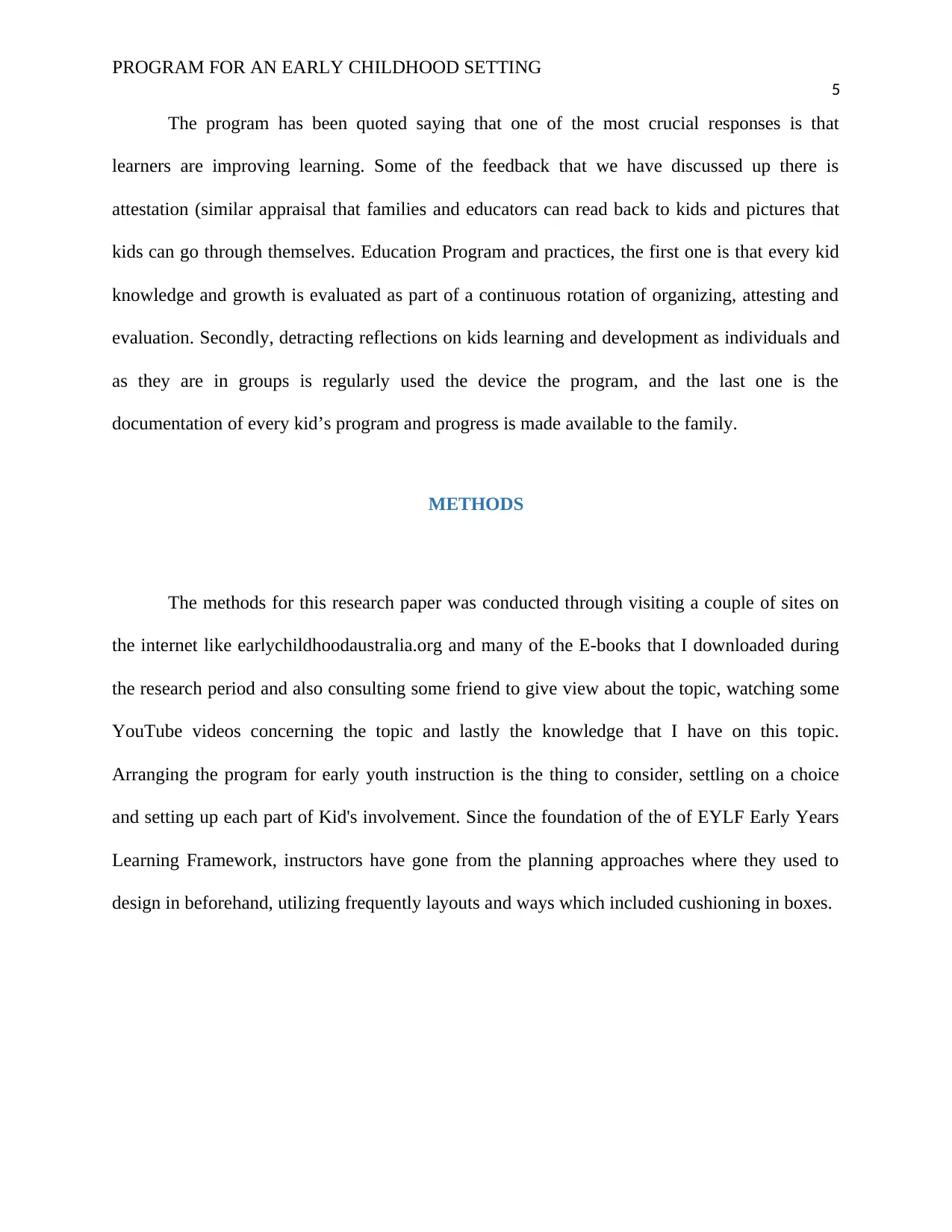
PROGRAM FOR AN EARLY CHILDHOOD SETTING
5
The program has been quoted saying that one of the most crucial responses is that
learners are improving learning. Some of the feedback that we have discussed up there is
attestation (similar appraisal that families and educators can read back to kids and pictures that
kids can go through themselves. Education Program and practices, the first one is that every kid
knowledge and growth is evaluated as part of a continuous rotation of organizing, attesting and
evaluation. Secondly, detracting reflections on kids learning and development as individuals and
as they are in groups is regularly used the device the program, and the last one is the
documentation of every kid’s program and progress is made available to the family.
METHODS
The methods for this research paper was conducted through visiting a couple of sites on
the internet like earlychildhoodaustralia.org and many of the E-books that I downloaded during
the research period and also consulting some friend to give view about the topic, watching some
YouTube videos concerning the topic and lastly the knowledge that I have on this topic.
Arranging the program for early youth instruction is the thing to consider, settling on a choice
and setting up each part of Kid's involvement. Since the foundation of the of EYLF Early Years
Learning Framework, instructors have gone from the planning approaches where they used to
design in beforehand, utilizing frequently layouts and ways which included cushioning in boxes.
5
The program has been quoted saying that one of the most crucial responses is that
learners are improving learning. Some of the feedback that we have discussed up there is
attestation (similar appraisal that families and educators can read back to kids and pictures that
kids can go through themselves. Education Program and practices, the first one is that every kid
knowledge and growth is evaluated as part of a continuous rotation of organizing, attesting and
evaluation. Secondly, detracting reflections on kids learning and development as individuals and
as they are in groups is regularly used the device the program, and the last one is the
documentation of every kid’s program and progress is made available to the family.
METHODS
The methods for this research paper was conducted through visiting a couple of sites on
the internet like earlychildhoodaustralia.org and many of the E-books that I downloaded during
the research period and also consulting some friend to give view about the topic, watching some
YouTube videos concerning the topic and lastly the knowledge that I have on this topic.
Arranging the program for early youth instruction is the thing to consider, settling on a choice
and setting up each part of Kid's involvement. Since the foundation of the of EYLF Early Years
Learning Framework, instructors have gone from the planning approaches where they used to
design in beforehand, utilizing frequently layouts and ways which included cushioning in boxes.
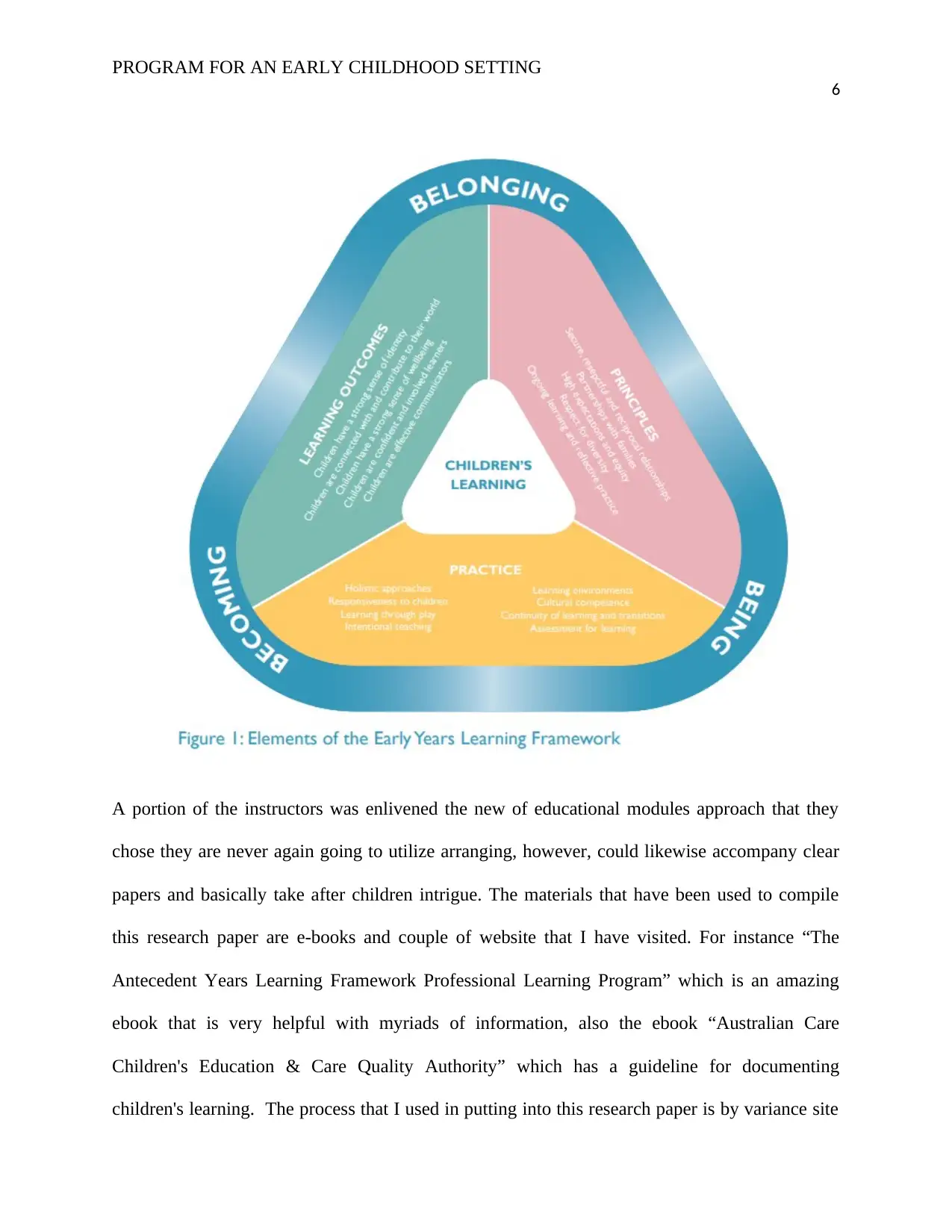
PROGRAM FOR AN EARLY CHILDHOOD SETTING
6
A portion of the instructors was enlivened the new of educational modules approach that they
chose they are never again going to utilize arranging, however, could likewise accompany clear
papers and basically take after children intrigue. The materials that have been used to compile
this research paper are e-books and couple of website that I have visited. For instance “The
Antecedent Years Learning Framework Professional Learning Program” which is an amazing
ebook that is very helpful with myriads of information, also the ebook “Australian Care
Children's Education & Care Quality Authority” which has a guideline for documenting
children's learning. The process that I used in putting into this research paper is by variance site
6
A portion of the instructors was enlivened the new of educational modules approach that they
chose they are never again going to utilize arranging, however, could likewise accompany clear
papers and basically take after children intrigue. The materials that have been used to compile
this research paper are e-books and couple of website that I have visited. For instance “The
Antecedent Years Learning Framework Professional Learning Program” which is an amazing
ebook that is very helpful with myriads of information, also the ebook “Australian Care
Children's Education & Care Quality Authority” which has a guideline for documenting
children's learning. The process that I used in putting into this research paper is by variance site
⊘ This is a preview!⊘
Do you want full access?
Subscribe today to unlock all pages.

Trusted by 1+ million students worldwide
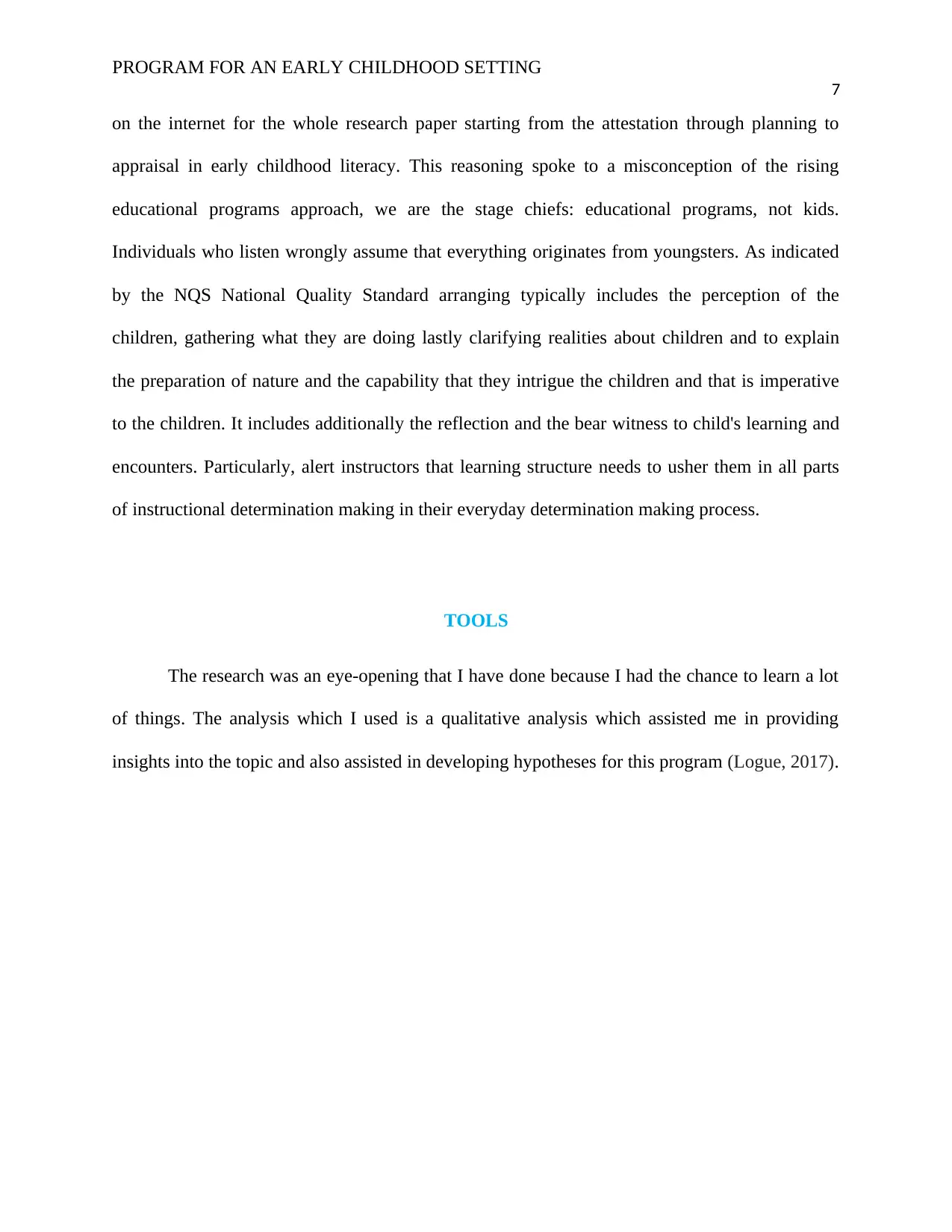
PROGRAM FOR AN EARLY CHILDHOOD SETTING
7
on the internet for the whole research paper starting from the attestation through planning to
appraisal in early childhood literacy. This reasoning spoke to a misconception of the rising
educational programs approach, we are the stage chiefs: educational programs, not kids.
Individuals who listen wrongly assume that everything originates from youngsters. As indicated
by the NQS National Quality Standard arranging typically includes the perception of the
children, gathering what they are doing lastly clarifying realities about children and to explain
the preparation of nature and the capability that they intrigue the children and that is imperative
to the children. It includes additionally the reflection and the bear witness to child's learning and
encounters. Particularly, alert instructors that learning structure needs to usher them in all parts
of instructional determination making in their everyday determination making process.
TOOLS
The research was an eye-opening that I have done because I had the chance to learn a lot
of things. The analysis which I used is a qualitative analysis which assisted me in providing
insights into the topic and also assisted in developing hypotheses for this program (Logue, 2017).
7
on the internet for the whole research paper starting from the attestation through planning to
appraisal in early childhood literacy. This reasoning spoke to a misconception of the rising
educational programs approach, we are the stage chiefs: educational programs, not kids.
Individuals who listen wrongly assume that everything originates from youngsters. As indicated
by the NQS National Quality Standard arranging typically includes the perception of the
children, gathering what they are doing lastly clarifying realities about children and to explain
the preparation of nature and the capability that they intrigue the children and that is imperative
to the children. It includes additionally the reflection and the bear witness to child's learning and
encounters. Particularly, alert instructors that learning structure needs to usher them in all parts
of instructional determination making in their everyday determination making process.
TOOLS
The research was an eye-opening that I have done because I had the chance to learn a lot
of things. The analysis which I used is a qualitative analysis which assisted me in providing
insights into the topic and also assisted in developing hypotheses for this program (Logue, 2017).
Paraphrase This Document
Need a fresh take? Get an instant paraphrase of this document with our AI Paraphraser
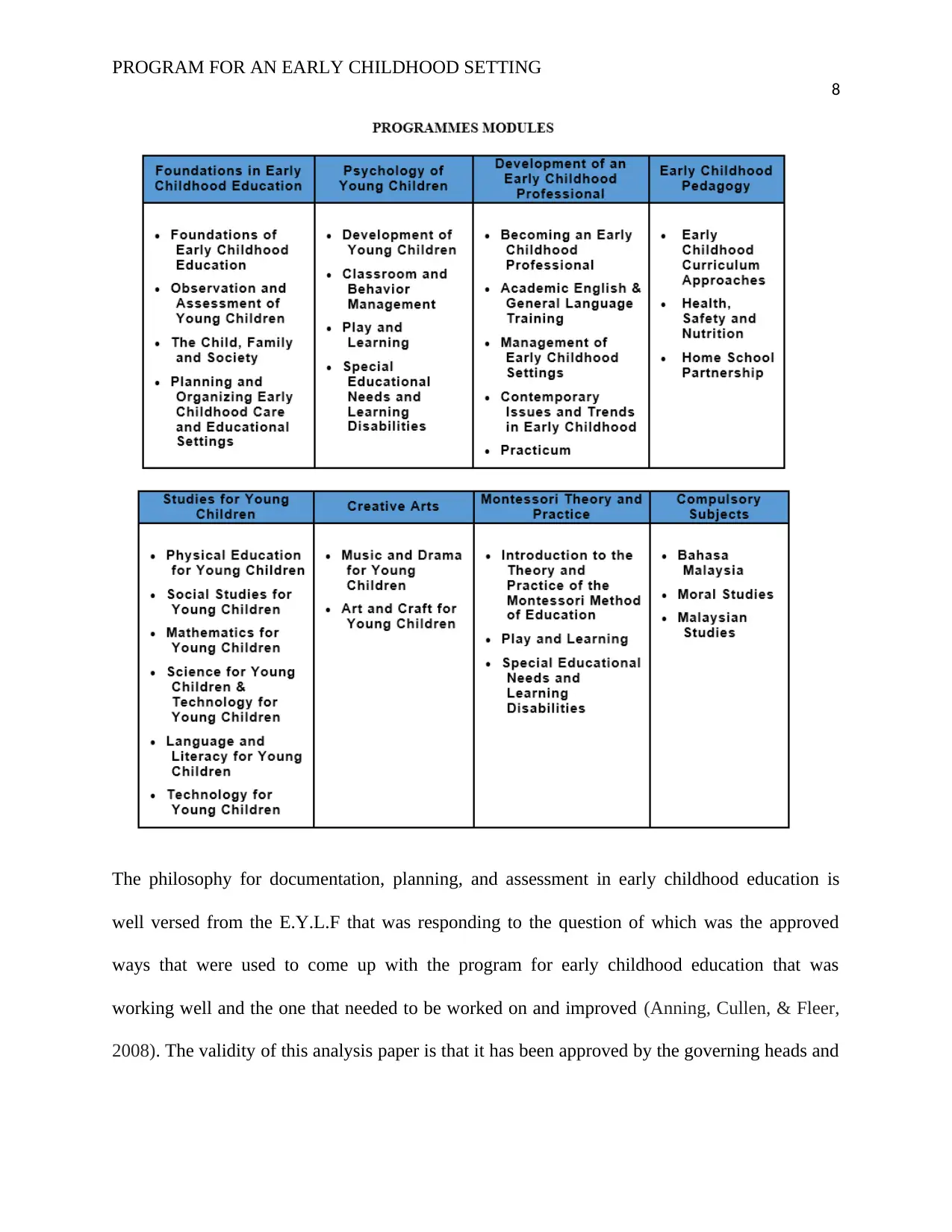
PROGRAM FOR AN EARLY CHILDHOOD SETTING
8
The philosophy for documentation, planning, and assessment in early childhood education is
well versed from the E.Y.L.F that was responding to the question of which was the approved
ways that were used to come up with the program for early childhood education that was
working well and the one that needed to be worked on and improved (Anning, Cullen, & Fleer,
2008). The validity of this analysis paper is that it has been approved by the governing heads and
8
The philosophy for documentation, planning, and assessment in early childhood education is
well versed from the E.Y.L.F that was responding to the question of which was the approved
ways that were used to come up with the program for early childhood education that was
working well and the one that needed to be worked on and improved (Anning, Cullen, & Fleer,
2008). The validity of this analysis paper is that it has been approved by the governing heads and
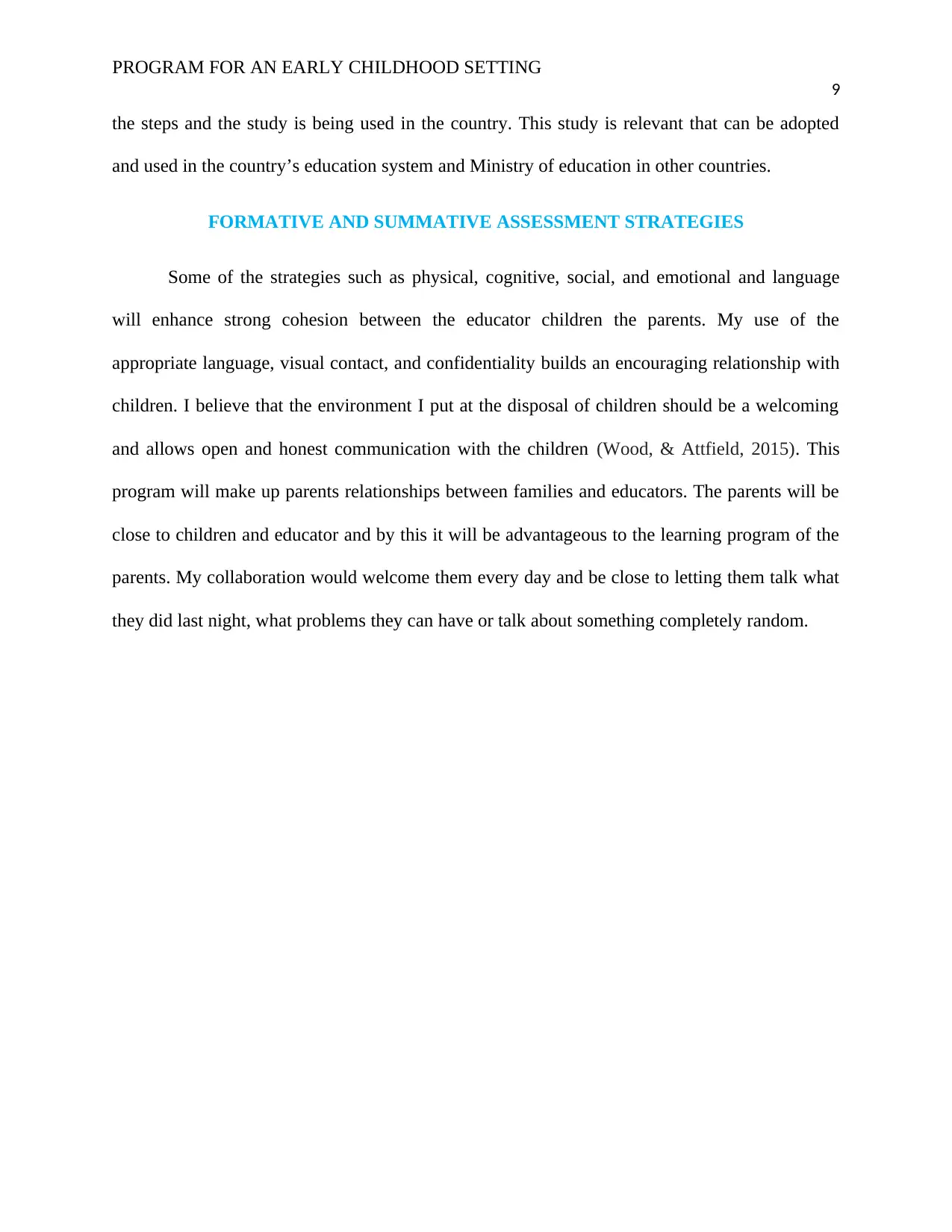
PROGRAM FOR AN EARLY CHILDHOOD SETTING
9
the steps and the study is being used in the country. This study is relevant that can be adopted
and used in the country’s education system and Ministry of education in other countries.
FORMATIVE AND SUMMATIVE ASSESSMENT STRATEGIES
Some of the strategies such as physical, cognitive, social, and emotional and language
will enhance strong cohesion between the educator children the parents. My use of the
appropriate language, visual contact, and confidentiality builds an encouraging relationship with
children. I believe that the environment I put at the disposal of children should be a welcoming
and allows open and honest communication with the children (Wood, & Attfield, 2015). This
program will make up parents relationships between families and educators. The parents will be
close to children and educator and by this it will be advantageous to the learning program of the
parents. My collaboration would welcome them every day and be close to letting them talk what
they did last night, what problems they can have or talk about something completely random.
9
the steps and the study is being used in the country. This study is relevant that can be adopted
and used in the country’s education system and Ministry of education in other countries.
FORMATIVE AND SUMMATIVE ASSESSMENT STRATEGIES
Some of the strategies such as physical, cognitive, social, and emotional and language
will enhance strong cohesion between the educator children the parents. My use of the
appropriate language, visual contact, and confidentiality builds an encouraging relationship with
children. I believe that the environment I put at the disposal of children should be a welcoming
and allows open and honest communication with the children (Wood, & Attfield, 2015). This
program will make up parents relationships between families and educators. The parents will be
close to children and educator and by this it will be advantageous to the learning program of the
parents. My collaboration would welcome them every day and be close to letting them talk what
they did last night, what problems they can have or talk about something completely random.
⊘ This is a preview!⊘
Do you want full access?
Subscribe today to unlock all pages.

Trusted by 1+ million students worldwide
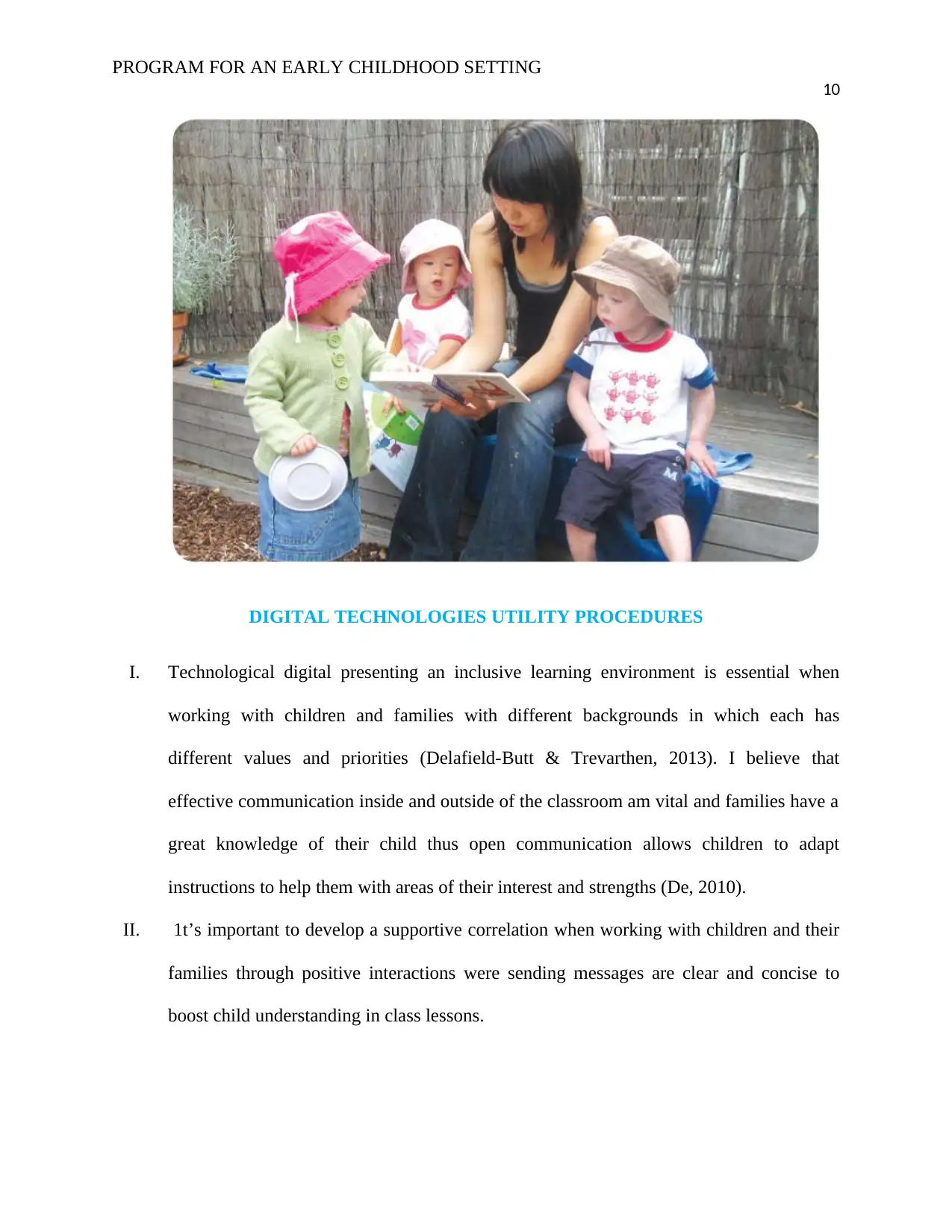
PROGRAM FOR AN EARLY CHILDHOOD SETTING
10
DIGITAL TECHNOLOGIES UTILITY PROCEDURES
I. Technological digital presenting an inclusive learning environment is essential when
working with children and families with different backgrounds in which each has
different values and priorities (Delafield-Butt & Trevarthen, 2013). I believe that
effective communication inside and outside of the classroom am vital and families have a
great knowledge of their child thus open communication allows children to adapt
instructions to help them with areas of their interest and strengths (De, 2010).
II. 1t’s important to develop a supportive correlation when working with children and their
families through positive interactions were sending messages are clear and concise to
boost child understanding in class lessons.
10
DIGITAL TECHNOLOGIES UTILITY PROCEDURES
I. Technological digital presenting an inclusive learning environment is essential when
working with children and families with different backgrounds in which each has
different values and priorities (Delafield-Butt & Trevarthen, 2013). I believe that
effective communication inside and outside of the classroom am vital and families have a
great knowledge of their child thus open communication allows children to adapt
instructions to help them with areas of their interest and strengths (De, 2010).
II. 1t’s important to develop a supportive correlation when working with children and their
families through positive interactions were sending messages are clear and concise to
boost child understanding in class lessons.
Paraphrase This Document
Need a fresh take? Get an instant paraphrase of this document with our AI Paraphraser
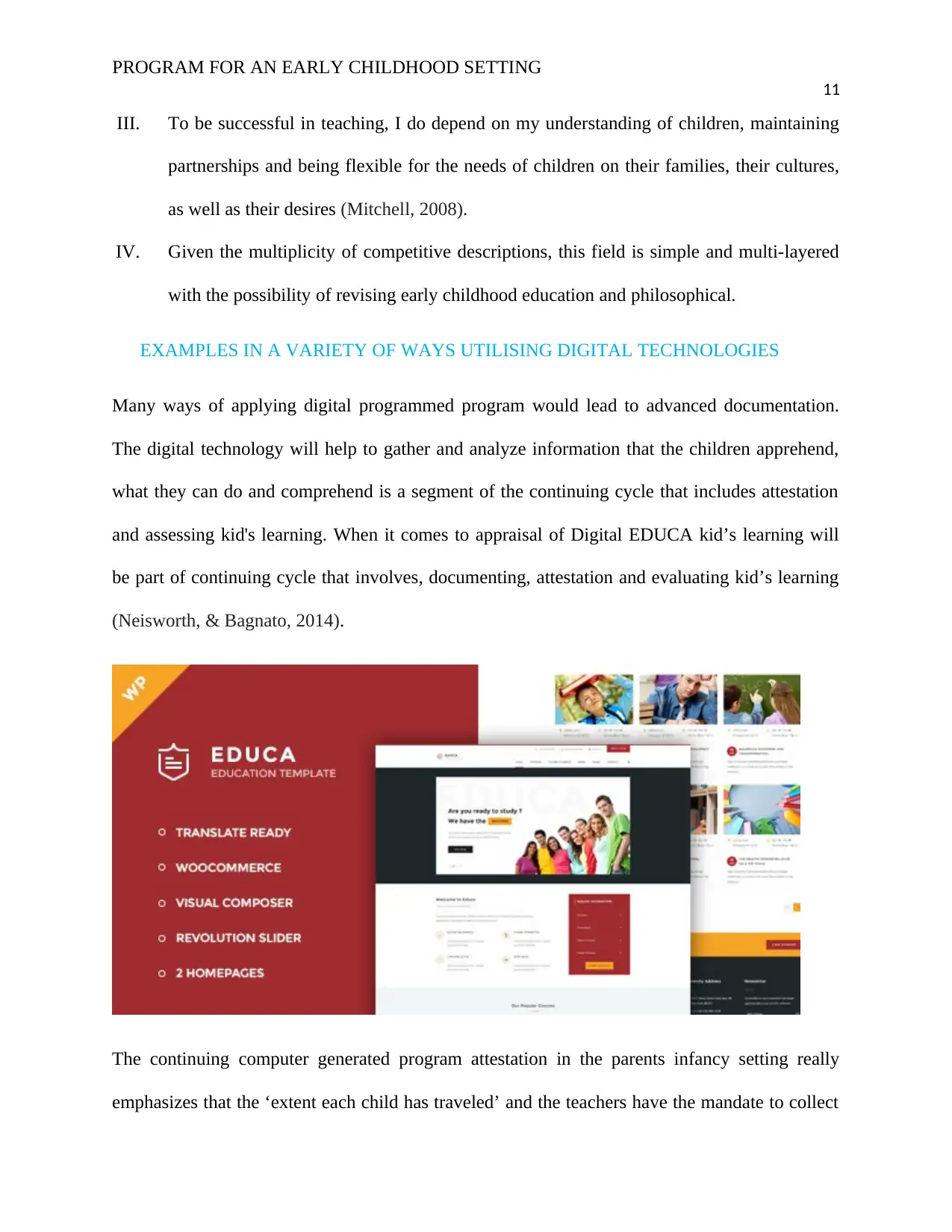
PROGRAM FOR AN EARLY CHILDHOOD SETTING
11
III. To be successful in teaching, I do depend on my understanding of children, maintaining
partnerships and being flexible for the needs of children on their families, their cultures,
as well as their desires (Mitchell, 2008).
IV. Given the multiplicity of competitive descriptions, this field is simple and multi-layered
with the possibility of revising early childhood education and philosophical.
EXAMPLES IN A VARIETY OF WAYS UTILISING DIGITAL TECHNOLOGIES
Many ways of applying digital programmed program would lead to advanced documentation.
The digital technology will help to gather and analyze information that the children apprehend,
what they can do and comprehend is a segment of the continuing cycle that includes attestation
and assessing kid's learning. When it comes to appraisal of Digital EDUCA kid’s learning will
be part of continuing cycle that involves, documenting, attestation and evaluating kid’s learning
(Neisworth, & Bagnato, 2014).
The continuing computer generated program attestation in the parents infancy setting really
emphasizes that the ‘extent each child has traveled’ and the teachers have the mandate to collect
11
III. To be successful in teaching, I do depend on my understanding of children, maintaining
partnerships and being flexible for the needs of children on their families, their cultures,
as well as their desires (Mitchell, 2008).
IV. Given the multiplicity of competitive descriptions, this field is simple and multi-layered
with the possibility of revising early childhood education and philosophical.
EXAMPLES IN A VARIETY OF WAYS UTILISING DIGITAL TECHNOLOGIES
Many ways of applying digital programmed program would lead to advanced documentation.
The digital technology will help to gather and analyze information that the children apprehend,
what they can do and comprehend is a segment of the continuing cycle that includes attestation
and assessing kid's learning. When it comes to appraisal of Digital EDUCA kid’s learning will
be part of continuing cycle that involves, documenting, attestation and evaluating kid’s learning
(Neisworth, & Bagnato, 2014).
The continuing computer generated program attestation in the parents infancy setting really
emphasizes that the ‘extent each child has traveled’ and the teachers have the mandate to collect
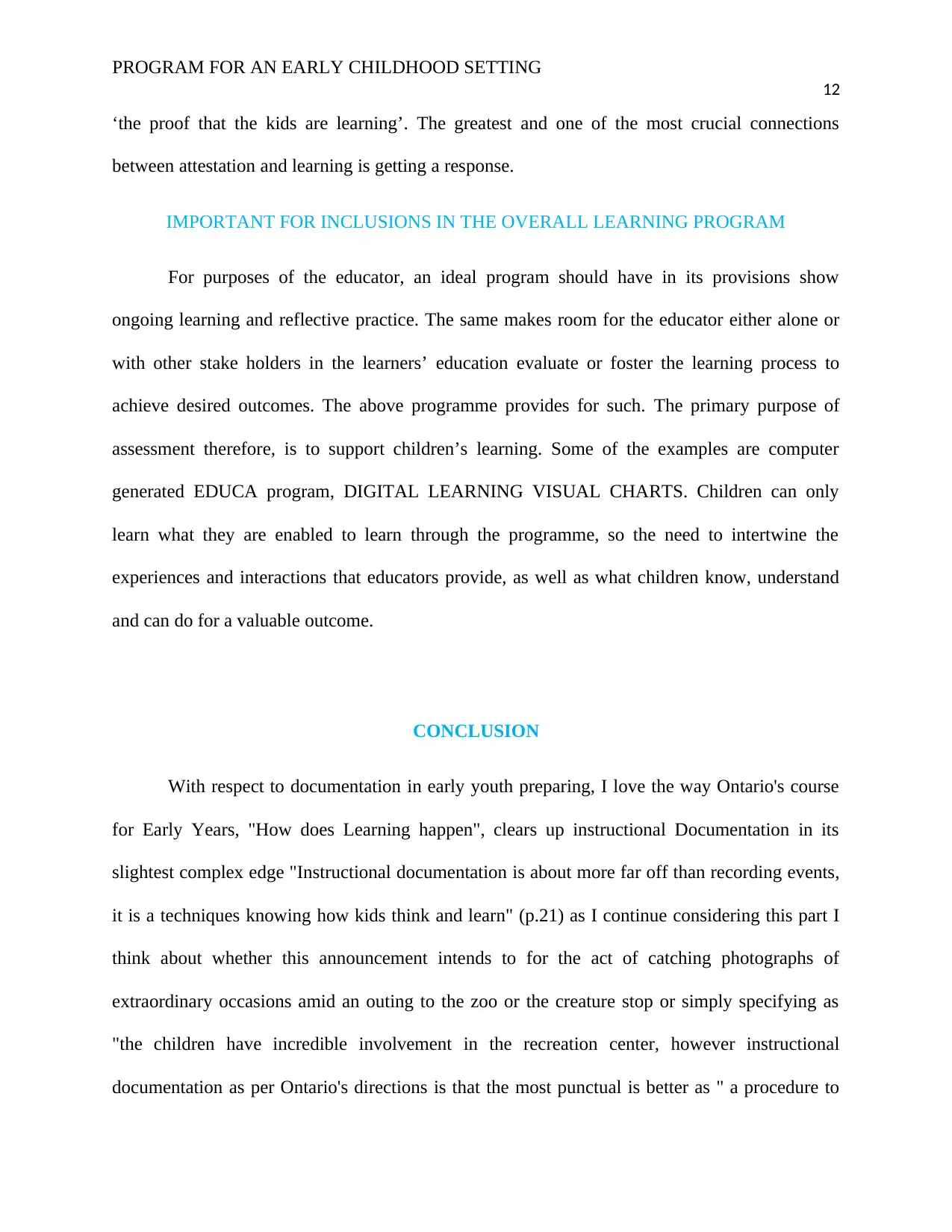
PROGRAM FOR AN EARLY CHILDHOOD SETTING
12
‘the proof that the kids are learning’. The greatest and one of the most crucial connections
between attestation and learning is getting a response.
IMPORTANT FOR INCLUSIONS IN THE OVERALL LEARNING PROGRAM
For purposes of the educator, an ideal program should have in its provisions show
ongoing learning and reflective practice. The same makes room for the educator either alone or
with other stake holders in the learners’ education evaluate or foster the learning process to
achieve desired outcomes. The above programme provides for such. The primary purpose of
assessment therefore, is to support children’s learning. Some of the examples are computer
generated EDUCA program, DIGITAL LEARNING VISUAL CHARTS. Children can only
learn what they are enabled to learn through the programme, so the need to intertwine the
experiences and interactions that educators provide, as well as what children know, understand
and can do for a valuable outcome.
CONCLUSION
With respect to documentation in early youth preparing, I love the way Ontario's course
for Early Years, "How does Learning happen", clears up instructional Documentation in its
slightest complex edge "Instructional documentation is about more far off than recording events,
it is a techniques knowing how kids think and learn" (p.21) as I continue considering this part I
think about whether this announcement intends to for the act of catching photographs of
extraordinary occasions amid an outing to the zoo or the creature stop or simply specifying as
"the children have incredible involvement in the recreation center, however instructional
documentation as per Ontario's directions is that the most punctual is better as " a procedure to
12
‘the proof that the kids are learning’. The greatest and one of the most crucial connections
between attestation and learning is getting a response.
IMPORTANT FOR INCLUSIONS IN THE OVERALL LEARNING PROGRAM
For purposes of the educator, an ideal program should have in its provisions show
ongoing learning and reflective practice. The same makes room for the educator either alone or
with other stake holders in the learners’ education evaluate or foster the learning process to
achieve desired outcomes. The above programme provides for such. The primary purpose of
assessment therefore, is to support children’s learning. Some of the examples are computer
generated EDUCA program, DIGITAL LEARNING VISUAL CHARTS. Children can only
learn what they are enabled to learn through the programme, so the need to intertwine the
experiences and interactions that educators provide, as well as what children know, understand
and can do for a valuable outcome.
CONCLUSION
With respect to documentation in early youth preparing, I love the way Ontario's course
for Early Years, "How does Learning happen", clears up instructional Documentation in its
slightest complex edge "Instructional documentation is about more far off than recording events,
it is a techniques knowing how kids think and learn" (p.21) as I continue considering this part I
think about whether this announcement intends to for the act of catching photographs of
extraordinary occasions amid an outing to the zoo or the creature stop or simply specifying as
"the children have incredible involvement in the recreation center, however instructional
documentation as per Ontario's directions is that the most punctual is better as " a procedure to
⊘ This is a preview!⊘
Do you want full access?
Subscribe today to unlock all pages.

Trusted by 1+ million students worldwide
1 out of 15
Related Documents
Your All-in-One AI-Powered Toolkit for Academic Success.
+13062052269
info@desklib.com
Available 24*7 on WhatsApp / Email
![[object Object]](/_next/static/media/star-bottom.7253800d.svg)
Unlock your academic potential
Copyright © 2020–2025 A2Z Services. All Rights Reserved. Developed and managed by ZUCOL.




